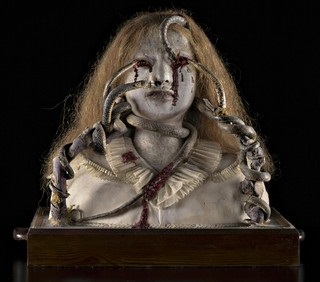Reperti di Anatomia Patologica
Anatomia Artistica

La suicida punita
Questo preparato, realizzato con la tecnica della tannizzazione da Lodovico Brunetti nel 1863, rappresenta una ragazza di 18 anni, di professione cucitrice, rinvenuta annegata sull’argine del fiume che all’epoca scorreva lungo la facciata posteriore dell’Ospedale Giustinianeo e adesso è interrato. Secondo le cronache del tempo si trattò di un suicidio provocato da una delusione amorosa. Nel corso dell’autopsia, Brunetti eseguì un calco in gesso del viso e della parte superiore del busto della ragazza. Successivamente scorticò la pelle del viso e del collo, la sgrassò con etere solforico e la fissò con acido tannico, rendendola imputrescibile. Applicò il tessuto così ottenuto sul calco, in cui la fisionomia della ragazza era stata riprodotta fissando occhi di vetro modellando orecchie di gesso e spalle ricoperte da un leggero tessuto di pizzo. Per nascondere le lacerazioni della pelle provocate dai ganci usati per recuperare il cadavere dal fiume, Brunetti concepì l’idea di rappresentare la punizione riservata all’inferno a coloro che avevano commesso il grave peccato del suicidio. Pose alcuni rami di legno di fronte al busto, sui quali avvolse dei serpenti tannizzati che coprivano gli squarci e sembravano in procinto di divorare il volto della ragazza. Fu Brunetti stesso a intitolare il preparato “La suicida punita”, catalogandolo come una produzione di “anatomia artistica”. Nel 1865 Brunetti inviò a Firenze un manifesto celebrativo in cui dedicava l’opera, insieme al “Simbolo della medicina razionale”, al seicentenario della nascita di Dante Alighieri. Nel 1867 entrambi i preparati, insieme a ulteriori organi e apparati tannizzati, entrarono a far parte dell’Esposizione Universale di Parigi. In quell’occasione, Brunetti venne premiato con il “Grand Prix” della sezione “arti e mestieri” per l’ottima qualità dei suoi reperti e per l’innovativa tecnica di preservazione dei corpi. La suicida punita fu oggetto di particolare ammirazione. Nel libretto accompagnatorio della collezione esposta da Brunetti, l’anatomopatologo si vantò di aver ricevuto complimenti dai parenti della ragazza per la precisione di cui aveva dato prova nel ricostruire la fisionomia della defunta. Si tratta di un caso straordinario, dunque, che rispecchia una cultura della morte molto lontana da quella attuale.
The punished suicide
This specimen, preserved in 1863 by Lodovico Brunetti using his own tanninisation method, portrays a girl aged eighteen, a seamstress, who was found drowned on the banks of the river which at the time ran beside the rear façade of the Justinian Hospital and today runs underground. Local chronicles at the time described the event as an act of suicide provoked by amorous delusion. During the autopsy, Brunetti made a plaster cast of the girl’s face and upper bust. After this, he peeled away the skin from her face and neck, scoured the flesh with sulfuric ether and then treated it with tannic acid to preserve it from putrefaction. He applied the resulting tissue over the plaster cast, where the girl’s features had been reproduced with the addition of glass eyes and plaster ears, while her shoulders were covered by a light lace fabric. In order to hide the gashes on her skin caused by the hooks used to drag the corpse from the water, Brunetti had the idea of making this exhibit an allegory representing the punishment reserved in hell for those guilty of the heinous crime of suicide: he placed some wooden branches on her chest, and then entwined them with tanninised snakes, placed to hide the wounds while seemingly poised to devour the girl’s face. Brunetti proudly gave this ‘artistic anatomy’ exhibit the title of “La suicida punita” (The Punished Suicide). In 1865, Brunetti sent a celebrative manifesto of this work to Florence, dedicating it, along with his “Simbolo della medicina razionale” (Symbol of Rational Medicine), as a homage to the six hundredth anniversary of the birth of Dante Alighieri. In 1867, both exhibits – together with various other tanninised organs and body parts – were accepted for display at the Paris Universal Exposition. As a result, Brunetti was awarded the Grand Prix in the Arts and Professions section, for his exhibits and his innovative method of preserving bodies. The “Punished Suicide” attracted great attention and admiration. In the booklet which accompanied Brunetti’s prize-winning exhibits, the anatomopathologist proudly described how the girl’s parents had complimented him for the precision shown in reconstructing their daughter’s features. An extraordinary case history, without a doubt, reminding us of the enormous difference between our own attitudes to death and the dead, and those of just 150 years ago.
References
Zampieri F et al. (2011-12). L'enigma della "Suicida punita": un preparato anatomico di Lodovico Brunetti vincitore della medaglia d'oro all'Esposizione Universale di Parigi del 1867. Physis.


